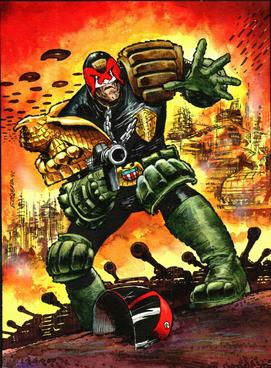
Judge Joseph Dredd is a fictional character created by writer John Wagner and artist Carlos Ezquerra. He first appeared in the second issue of the British weekly anthology comic 2000 AD (1977). He is the magazine's longest-running character, and in 1990 he got his own title, the Judge Dredd Megazine. He also appears in a number of film and video game adaptations.

2000 AD is a weekly British science fiction-oriented comic magazine. As a comics anthology it serialises stories in each issue and was first published by IPC Magazines in 1977, the first issue dated 26 February. Since 2000 it has been published by Rebellion Developments.

Mega-City One is a fictional city that features in the Judge Dredd comic book series and related media. A post-nuclear megalopolis covering much of what is now the Eastern United States and some of Canada, the city's exact geography depends on the writer and artist working the story. From its first appearance it has been associated with New York City's urban sprawl; originally presented as a future New York, it was retconned as the centre of a "Mega-City One" in the third issue.

Rogue Trooper is a science fiction strip in the British comic 2000 AD, created by Gerry Finley-Day and Dave Gibbons in 1981. It portrays the adventures of a "Genetic Infantryman" named Rogue and three uploaded minds mounted on his equipment who search for the Traitor General who betrayed their regiment to the enemy.
Gordon Rennie is a Scottish comics writer, responsible for White Trash: Moronic Inferno, as well as several comic strips for 2000 AD and novels for Warhammer Fantasy.
Ro-Busters is a British comic story that formed part of the original line-up of the magazine Starlord. Similar in premise to that of the Thunderbirds television series, it was created by writer Pat Mills and was drawn by Carlos Pino and Ian Kennedy initially, before Starlord's merger with 2000 AD. After the merger, Dave Gibbons, Kevin O'Neill and Mike McMahon were regular artists on the series, along with occasional contributions from Mike Dorey.

Tornado was a British weekly boys' adventure comic published by IPC Magazines from 24 March to 18 August 1979. The comic was partly created as a way to use up stories already commissioned for the other titles, and was marred by a difficult production. Tornado sold poorly and was merged with 2000 AD after 22 issues.
Massimo Belardinelli was an Italian comic artist best known for his work in the British science fiction comic 2000 AD.
Robbie Morrison is a Scottish comic book writer known for his work in the weekly anthology 2000 AD, where he co-created the long-running serial Nikolai Dante with artist Simon Fraser.
Siku is the pseudonym of British/Nigerian artist and writer Ajibayo Akinsiku, best known for his work in 2000 AD.

Tom Tully was a noted British comic writer, mostly of sports and action-adventure stories. He was the longest-running writer of the popular football-themed strip Roy of the Rovers, which he wrote for much of Roy Race's playing career until the weekly comic closed in 1993. Other notable strips penned by Tully included The Steel Claw, The House of Dolmann, The Incredible Adventures of Janus Stark, The Leopard from Lime Street, The Robo Machines, and Harlem Heroes. During his three-decade career, Tully wrote exclusively for what became known as the IPC line of publishers: Amalgamated Press/Odhams/Longacre Press/Fleetway/IPC Magazines.
Michael Molcher is a British journalist and magazine editor, who is originally from Leeds. His book I Am the Law: How Judge Dredd Predicted Our Future won an Eisner Award in 2024. He also produced the small press magazine The End Is Nigh.
Friday is a comics character who appeared in the British anthology 2000 AD between 1989 and 1996. He was created by writer Dave Gibbons and artist Will Simpson. Subsequently Michael Fleisher and then Steve White took over as regular series writers. Friday was the lead character of the new Rogue Trooper series, which was a reboot of the original 1981 series, of which Gibbons had been the creator artist.
John Tomlinson is a British comic book writer and editor known for his work on various 2000 AD strips. He has occasionally been credited as Sonny Steelgrave.

2000 AD crossovers are crossover stories appearing in British comic 2000 AD, its sister title the Judge Dredd Megazine, and other related output, such as novels, audio plays, films and role-playing games.

This is a list of works by Scottish author Alan Grant.
John Wagner has worked on a wide range of British comics most notably working on Judge Dredd and the various spin-offs.

Pat Mills has written comics since the early seventies.
Kev Hopgood is a British comic artist who has been drawing comic books since 1984. He specialises in artwork for science fiction and fantasy comics.
Judge Dredd: The Mega Collection was a British fortnightly partwork collection of hardback books published by Hachette Partworks. The series is made up of 90 volumes which contain thematic collections of stories about 2000 AD’s Judge Dredd and related characters, as well as bonus material including previously unpublished art. The spine art on the books combine to display a new image by artist Patrick Goddard. The series was also accompanied by the launch of a series of podcasts called '2000 AD Thrill-Casts' which, after the 6th episode, widened its focus to 2000 AD in general. On 5 July 2017 it was officially announced that the series had been extended from 80 to 90 issues.